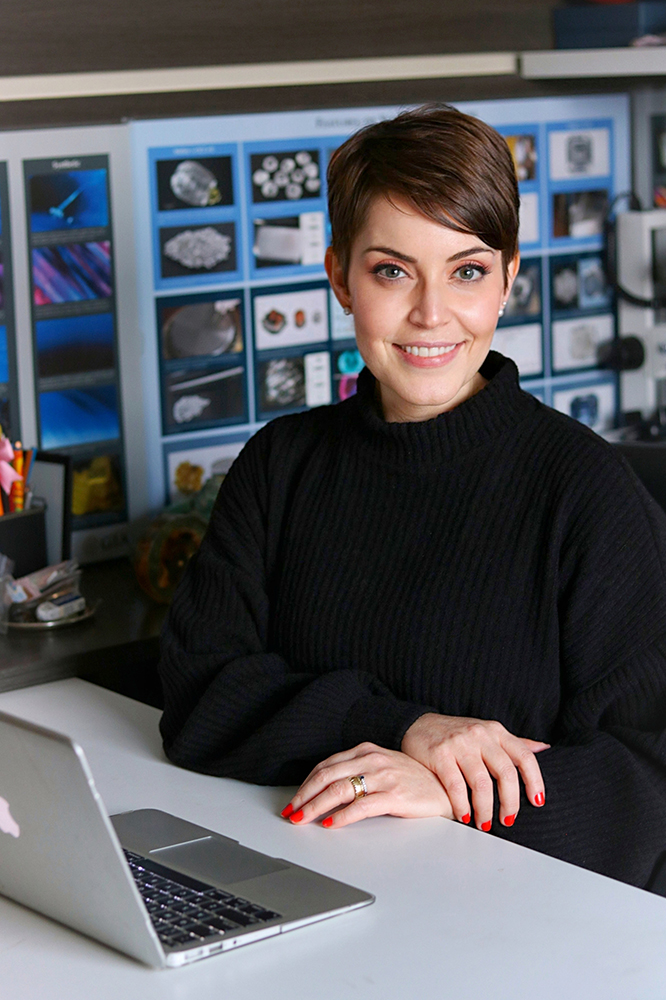This year, the Training Centre of the German Gemmological Association celebrates its 50th anniversary. During the preparations for this anniversary, we got in touch with many alumni – and their comments and stories confirm, how important their time here in Idar-Oberstein was for their future professional career. Over the next weeks and months, we will share the interviews with them in our blog, to inspire new gemmologists with the diversity of career opportunities in the jewellery and gemstone industry.
 Andressa Borotti is a gemmologist (FGG, EG), consultant and professor from Sao Paulo in Brazil. Currently, she is also pursuing her Ph.D. at the Universitiy of Sao Paulo, where she also works as a instructor in the gemmology classes of Prof. Dr. Rainer Schultz-Güttler, a long-term friend and colleague of our association.
Andressa Borotti is a gemmologist (FGG, EG), consultant and professor from Sao Paulo in Brazil. Currently, she is also pursuing her Ph.D. at the Universitiy of Sao Paulo, where she also works as a instructor in the gemmology classes of Prof. Dr. Rainer Schultz-Güttler, a long-term friend and colleague of our association.
When and why did you complete your training at the DGemG?
I completed my training at the German Gemmological Association in Idar-Oberstein in 2014, obtaining the FGG qualification. My primary objective was to strengthen my technical knowledge in gem identification and analysis, especially regarding diamonds, colored gemstones, pearls, and organic substances. I returned in 2015 to take the examination of the Federation of European Education in Gemmology (FEEG) and later returned for a refresher course in 2019 and pursued further training in scientific methods in 2023. The reason I chose the Institute was because I knew it to be a place where scientific knowledge is of the highest standard and a global reference, and that was exactly what I was looking for.
What was the most significant experience during your time in Idar-Oberstein?
First, being immersed in a city that is one of the world’s most traditional gemmological centers but also a historically significant hub for the trade and cutting of gemstones. Second, the opportunity to study with internationally recognized specialists (Dr. Henn, Dr. Schmitz, Dr. Schollenbruch, Dr. Stephan and Mrs. Wang). Third, handling the institute's extensive and comprehensive collection with a wide range of gem materials contributed greatly to my technical development. I appreciated every opportunity to visit the collections room. That was a highly enriching experience!
What aspects of the training programme did you value most?
The programme's strong emphasis on combining scientific methodology with practical application was its most valuable aspect. The structured curriculum, access to a comprehensive collection of gem specimens, and instruction grounded in rigorous standards provided a solid foundation for professional practice. Furthermore, the expertise of the instructors was essential to an excellent learning experience, complemented by the quantity and quality of the available materials and instruments.
What knowledge do you apply in your current professional activities?
The diagnostic techniques and classification methods learned at DGemG are essential to my daily work. They are applied in teaching, technical evaluations, gem identification, and legal consultancy, particularly in my roles involving the preparation of expert reports for legal proceedings at the Court of Justice of Sao Paulo and the Customs of the Brazilian Federal Revenue Service at Viracopos Airport.
How has the training influenced your career?
The DGemG training has had a significant impact on my career. It strengthened my qualifications, supported my recognition as a gemmologist and European Gemmologist (EG), and contributed to the credibility I bring to both academic and legal environments. It also helped establish a solid foundation for my continued work in education and consultancy.
What is your current professional role?
I currently work as a gemmologist, expert consultant and a professor. I lecture at institutions such as the Istituto Europeo di Design (IED) and Pontifical Catholic University of Campinas (PUC-Campinas), and I provide technical expertise for the Sao Paulo Court of Justice and the Customs of the Brazilian Federal Revenue Service at Viracopos Airport. I also run an independent consultancy, A Gemmologist, and am pursuing a Ph.D. at the University of Sao Paulo, where I focus on the intersection of gemmology, jewellery, sustainability, and social context. Since 2013, I have been serving as an assistant and instructor to Dr. Rainer Aloys Schultz-Güttler in his gemmology classes and laboratory at the University of Sao Paulo.
Do you have a preferred gemstone?
Among the many gemstones I work with, Emerald and Tanzanite stands out due to their fascinating colour and beauty. Emeralds, in particular, are not only valued for their aesthetic and compositional qualities but also for their rich historical significance. The unique characteristics of both stones make them especially relevant for gemmological study and jewellery applications.


